What is bleeding?
Bleeding, also called hemorrhage, is the term used to describe the blood that escapes from the blood vessels. Bleeding of the skin occurs if there is a lesion on the surface of the skin, and can sometimes occur spontaneously. The smallest areas of bleeding are known as petechiae (each point is <2 mm) y purple (2mm to 1cm).
Subungual Hemorrhage, or bleeding under the nail plate, produces a painful or inadvertent purplish-black discoloration. The discoloration can persist for months as the nail carries blood with it as it grows.
Examples of bleeding skin lesions
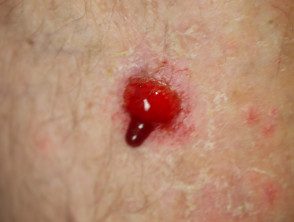
Basal cell carcinoma bleeding
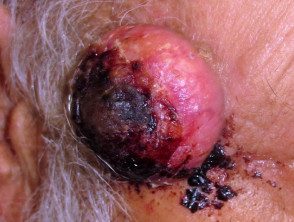
Squamous cell carcinoma with crust
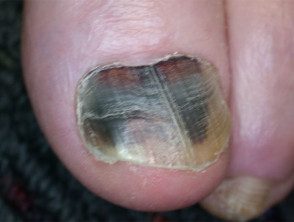
Subungual hematoma
What are bruises?
A hematoma, also known as ecchymosis or a contusion, occurs when small blood vessels (capillaries) under the skin bleeding, while the overlying skin remains intact. The injury causes blood to leak and pool near the surface of the skin, causing bluish-black discoloration of the skin.
Deeper bruises result in a hematoma - a collection of blood found within the tissues or cavities of the body.
Bruising

Traumatic contusion
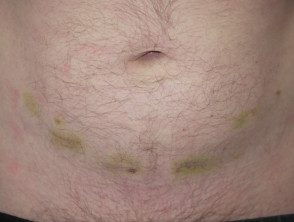
Bruising at the site of heparin injections

Ecchymoses associated with atrophy of the skin.
Who bleeds / bruises?
Anyone can bleed from a cut or develop a bruise after an injury. The severity of the bleeding depends on the impact of an injury. Repeated bleeding from the skin. injury with minimal provocation can be a sign fur Cancer, more often basal cell carcinoma.
Occasional bruising is normal and does not require medical attention. Bleeding and bruising are more common in certain people, such as:
- People with lighter skin tones, where bruises are more visible.
- People who exercise a lot or play contact sports.
- Older people, as the walls of their blood vessels weaken and their skin becomes thinner
-
People with an inherited or acquired coagulation disorder.
Bruising occurs more easily in certain places where blood collects easily, such as when a relatively minor bump results in a black eye.
What causes bleeding and bruising?
After an injury, the body immediately tries to stop any loss of blood.
- Platelets accumulate and block any defect in the blood vessel walls
- Blood vessels constrict.
- Clotting factors are released.
Defects in any of these three responses can lead to spontaneous or excessive bleeding and bruising.
Platelets can be dysfunctional or decreased in number. This can be due to conditions such as:
- Applastic anemia
- Leukemia
- Autoimmune disorders, such as systemic lupus erythematosus
- Disseminated intravascular coagulation
- Hemolytic uremic syndrome
- Thrombotic thrombocytopenic purpura
- Nephropathy
-
Drugs that affect platelets (eg, Aspirin and clopidogrel), such as prescription drugs to prevent heart attacks and strokes, and nonsteroidal anti-steroidsinflammatory drugs
Blood vessel defects, where the vessels are crooked or enlarged, include:
- Vasculitis
- Vitamin C deficiency
- Marfan syndrome
-
Ehlers-Danlos syndrome.
A clotting factor deficiency may be due to medications that affect clotting factors (eg, Warfarin, heparin, rivaroxaban, and apixaban). They are often prescribed for atrial fibrillation or a recent blood clot in the veins or lungs. A clotting factor deficiency can also be the result of a medical condition, such as:
- Liver disease
- Hemophilia
- Vitamin K deficiency
- Von Willebrand disease
- Deficiencies in other clotting factors.
The use of systemic or current Steroids can also increase the likelihood of bruising.
Signs of bleeding disorders.
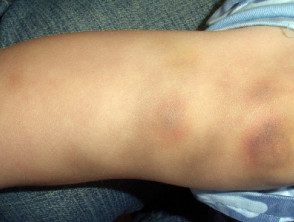
Hemophilia bruises
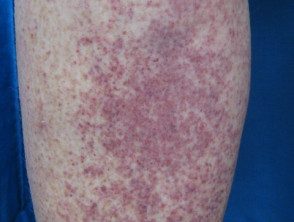
Petechiae due to thrombocytopenia
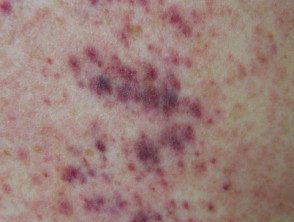
Petechiae due to thrombocytopenia
What are the symptoms of bleeding and bruising?
Larger blood vessels, such as arteries, lead to heavier and longer bleeding than smaller ones, such as capillaries. Once the bleeding has stopped, a blackish color Cortex or a scab forms as the wound heals underneath.
Usually a bruise appears first as a reddish patch, which develops over a few hours into a blue, black, or purple discoloration. You may feel tender immediately after bruising and the area may be inflamed. Within a few days, the color fades to a yellowish-green, as the filtered blood breaks down.
What tests can be performed?
Testing for bruises is generally not required. However, if a broken bone is suspected, an X-ray may be required.
If bruising occurs for no reason or with extreme frequency, blood tests may be required to confirm a platelet defect and determine if there is an underlying medical problem.
- Petechiae may be due to a platelet defect.
- Pigmented purpura may indicate capillaritis.
- Palpable purpura suggests vasculitis.
- Large contusions suggest clotting factor deficiencies due to liver disease or von Willebrand disease.
- Bleeding in the joints may indicate hemophilia.
- Exudate around catheters and blood collection sites in a sick patient may indicate disseminated intravascular coagulation, vitamin K deficiency, or thrombocytopenia.
When should I seek medical attention?
Urgent medical attention is required if the bruise is associated with extreme swelling and pain, as it could indicate a fracture in the underlying bone.
A medical evaluation is also indicated to:
- Bruises that are more frequent or severe than normal
- Bruises for no reason
- Bleeding from the gums, intestines, or urine.
- Significant bruising or bleeding when taking anticoagulant medications.
- Painful bruises under the nails.
What is the treatment for bruises?
There is no particular medical treatment for bruises. However, there are some techniques that can be used at home to reduce swelling and speed up the healing process.
- Prepare an ice pack wrapped in a cold towel or flannel. Apply this to the affected area for 30 minutes, as soon as possible after the injury.
- If practical, keep the bruised area elevated after the injury.
- Acetaminophen can help with severe pain.
Nonsteroidal anti-inflammatory Medications such as aspirin and ibuprofen are not recommended as they can worsen the bleeding that leads to the bruise.
What is the result of the bruises?
Bruises usually take about two weeks to go away. They may take longer to disappear from the lower legs.
How can I prevent bruises?
- Wear protective clothing and equipment, such as shin guards, when playing sports.
- Keep furniture and other large objects away from walkways.
- Avoid obstacles, such as cables that can cause tripping.
- If you are taking blood-thinning medications, check your blood through regular tests and appointments.
- Make sure your diet has adequate vitamin C, which is found in fresh fruits and vegetables.

